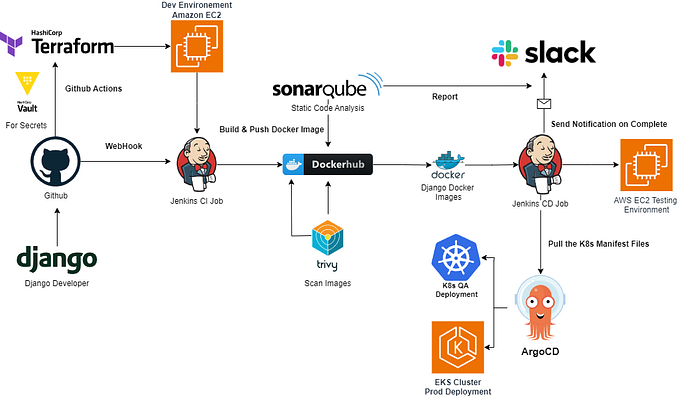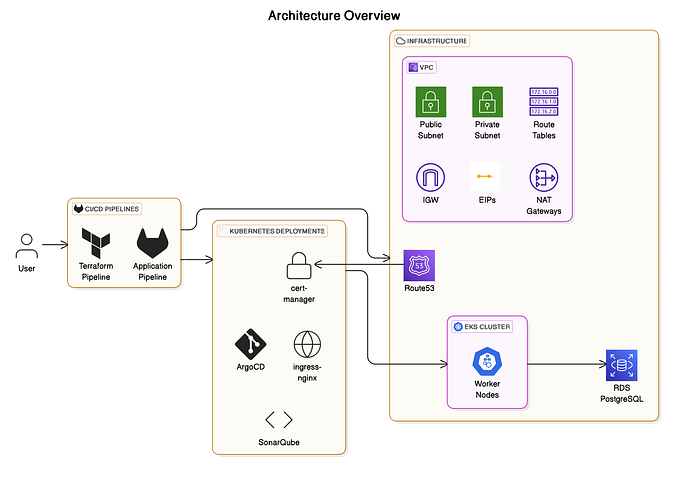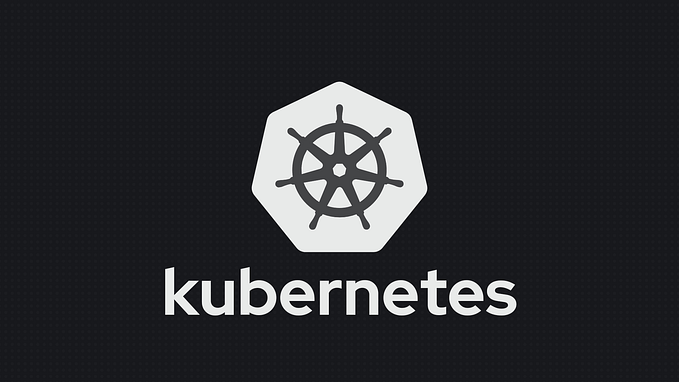Kubernetes For Beginners
Architecture & Components
Hello Readers, Welcome back !
Lets talk about Kubernetes & start from the scratch. #Beginners

Kubernetes:
It is a portable, extensible, open-source platform for managing containerized workloads and services. It has a large, rapidly growing ecosystem. Kubernetes services, support, and tools are widely available.
Container:
A container is a ready-to-run software package, containing everything needed to run an application: the code and any runtime it requires, application and system libraries, and default values for any essential settings.
Nodes:
A node is a machine either physical or virtual machine on which Kubernetes is installed. A node is a worker machine and this is where containers inside the pods will be launched by Kubernetes.
Pod:
A pod is the smallest deployable unit that can be managed by Kubernetes. A pod is a logical group of one or more containers that share the same IP address and port space. The main purpose of a pod is to support co-located processes, such as an application server and its local cache.

Master Node: (aka Control Plane)
- The Master node (Brain) manages the worker nodes (Body) and the Pods in the cluster.
- Its components are as depicted in the diagram ( ETCD, Kube-apiserver, Kube-scheduler etc )
- The master makes global decisions about the cluster and they also detect and respond to cluster events like starting up a new pod when a deployment’s field “replicas” is unsatisfied. (replicas dictate the number of identical structures of nodes to be kept at any given point in time)
- Master components, set up scripts typically start all master components on the same machine, and do not run user containers on this machine for the sake of simplicity.
Worker Node:
- The worker nodes are the part of the Kubernetes clusters which actually execute the containers and applications on them.
- These worker nodes have docker containers for each application running on them. There may be a different number of containers running on each node depending on the distribution of the workload.
- Worker nodes are generally more powerful than master nodes because they have to run hundreds of clusters on them.
- However, master nodes hold more significance because they manage the distribution of workload and the state of the cluster.

ETCD:
- It is a distributed reliable key-value store(database) that is easy to install, secure, persistence, highly available & fast.
- Its used to store & retrieve small bit of cluster data which requires fast read & write.
- Its not a traditional/relational database rather a Key-value format database store.
- It stores information regarding the cluster i.e., Nodes, PODs, Secrets, Configs, Roles, Accounts etc.
- Installation — Download Binaries -> Extract -> Run ETCD Service.
- Default port 2379 & Default client etcdctl.
- ETCDCTL is the CLI tool used to interact with ETCD.
KUBE CONTROLLER:
- It manages various controllers & it has its own set of responsibilities.
- It is a process which continuously monitors the state of components & works towards bringing the cluster to desired state.
- There are ample amount of controllers such as Deployment, Replica set, Endpoint, Job, Node, Namespace etc.
- Logically, each controller is a separate process, but to reduce complexity, they are all compiled into a single binary and run in a single process.
- It is similar to our “police department”, which continuously checks the status of the city & takes action to remediate the situation accordingly.
KUBE-APISERVER:
- It is a primary management component in Kubernetes.
- The API server is a component of the Kubernetes master node (Control Plane) that exposes the Kubernetes API.
- It authenticates user, validates requests + retrieves & updates data from ETCD Cluster.
- kubectl is used to communicate with kube-apiserver or we can invoke api directly by sending a POST method request.
KUBE-SCHEDULER:
- It is only responsible for deciding which pod goes on which node.
- Which get decided on certain criterion ( CPU, Memory etc )
- Firstly scheduler tries to filter out the nodes that do not fit for pod.
- Secondly it give priority to nodes having optimal resource usage.
- REMEMBER “It does not actually place the pod on the nodes”
KUBELET:
- An agent that runs on each node in the cluster & also makes sure that containers are running in a POD. #Informer
- The kubelet in the worker node, registers the node with the kubernetes cluster.
- The kubelet continues to monitor the state of the POD and the containers in it and reports to the kube-apiserver on a timely basis.
- The kubelet doesn’t manage containers which were not created by Kubernetes.
KUBE-PROXY:
- kube-proxy is a network proxy that runs on each node in your cluster.
- Its job is to look for new services and every time a new service is created it creates the appropriate rules on each node to forward traffic to those services to the backend pods.
- kube-proxy maintains network rules on nodes.
- These network rules allow network communication to your PODs from network sessions inside or outside of your cluster.
- One way it does this is using IPTABLES rules.
#community #opensource #aws #K8s #EKS #docker #computing

I am Kunal Shah, AWS Certified Solutions Architect, helping clients to achieve optimal solutions on the Cloud. Cloud Enabler by choice, DevOps Practitioner having 7+ Years of overall experience in the IT industry.
I love to talk about Cloud Technology, DevOps, Digital Transformation, Analytics, Infrastructure, Dev Tools, Operational efficiency, Serverless, Cost Optimization, Cloud Networking & Security.
You can reach out to me @ acloudguy.in
In the next article I’ll try to jump into the depth of kubernetes.
Until then, Keep learning :)
Also don't forget to hit the clap button if you like the article !!









